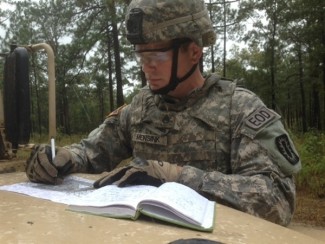 PHOTO: Army Staff Sgt. David Mensink removed a grenade from a man's leg in an ambulance outside of the University of Alabama Hospital in Birmingham, Ala., Oct. 11, 2014. Courtesy photo BIRMINGHAM, Ala., – An explosive ordnance disposal soldier removed a grenade from a man's leg in an ambulance outside of the University of Alabama Hospital here Oct. 11.
PHOTO: Army Staff Sgt. David Mensink removed a grenade from a man's leg in an ambulance outside of the University of Alabama Hospital in Birmingham, Ala., Oct. 11, 2014. Courtesy photo BIRMINGHAM, Ala., – An explosive ordnance disposal soldier removed a grenade from a man's leg in an ambulance outside of the University of Alabama Hospital here Oct. 11.
Army Staff Sgt. David Mensink from the 789th EOD Company, based at Fort Benning, Georgia, received a call from the Birmingham Police Department bomb squad around 1 a.m. The police sought Mensink's advice to determine what kind of explosive item was stuck in the man's leg. "From the initial X-ray, it looked like a 40mm grenade," said Mensink, a 27-year-old Iraq and Afghanistan veteran from Seale, Alabama.
Explosive was a military round Once the police discovered that the explosive was a military round, Mensink and his EOD team were called to support a team of federal, state and local law enforcement agencies on scene. The agencies involved included the Bureau of Alcohol, Tobacco, Firearms and Explosives; the FBI; Alabama State Bureau of Investigations; and the police departments of Birmingham and the Jasper, Alabama. Escorted by Alabama state troopers from the Georgia-Alabama state line, the team left Fort Benning at 4:15 a.m. and arrived at the hospital two hours later. The man was isolated inside the ambulance behind barricades more than 30 feet from the hospital with two paramedics who volunteered to stay with him. On his first trip into the ambulance, Mensink discovered that the grenade was lodged so deeply in the man's thigh that it exposed his femoral artery. Mensink returned to the ambulance with a doctor who volunteered to make an incision in the man's leg, while a paramedic stood by with tourniquet in case the man's artery was damaged. Another paramedic monitored his vital signs. Mensink then carefully removed the grenade from his leg. Paramedics rushed the man into the hospital. Officials said the man had no permanent damage.
Priming charge could have been fatal The explosive turned out to be an M713 red-smoke grenade. According to Mensink, the priming charge on the smoke grenade could have been fatal if it had detonated. The man told authorities that the grenade activated and fired into his thigh while he was dismantling it. He initially sought treatment at the Walker Baptist Medical Center in Jasper, and later was taken to the hospital in Birmingham, a Level 1 trauma center. In addition to Mensink, the 789th EOD Company Team consisted of Army Sgt. Johnny Lowthorpe from Columbus, Georgia, and Army Spc. Brandon Fair from Daytona Beach, Florida. The team was accompanied by Army Sgt. 1st Class Tyron Mathews from Royal, Florida, senior EOD officer. The EOD team was part of the 789th EOD Company, 184th EOD Battalion, 52nd EOD Group, 20th Chemical, Biological, Radiological, Nuclear, Explosives Command. The 20th CBRNE Command combats chemical, biological, radiological, nuclear and explosive hazards around the globe. Stationed on 19 posts in 16 states and headquartered on Aberdeen Proving Ground, Maryland, 20th CBRNE is the Defense Department's only standing multifunctional formation focused on conducting defense support to civil law enforcement agency missions.
More than 2,000 explosive mitigation missions During fiscal year 2014, 20th CBRNE Command EOD technicians completed more than 2,000 explosive mitigation missions across the nation. Capt. Ryan M. Plemmons, commander of the 789th EOD Company, said the incident was the most unusual mission his company had accomplished during his time in command. "It definitely shows why I have such confidence in my soldiers," said Plemmons, a Reno, Nevada native who served in Afghanistan. "Everybody worked together well to make sure that we completed the mission." Mensink said he became an EOD technician "because of its challenging mission set." "Explosive ordnance disposal technicians directly defeat our current enemy's weapon of choice," said Mensink, a 9-year U.S. Army veteran who previously served as an infantry soldier. Out of the 180 EOD missions Mensink has been involved in, both at home and in Afghanistan, he said, none were as unusual as removing a grenade from man's thigh. "It was definitely a first," he said.
Written Oct. 15, 2014 By: Walter Ham 20th Chemical, Biological, Radiological, Nuclear, Explosives Command
Republished and redistributed by permission of DoD.






